Application of the GPM-IMERG Products in Flash Flood Warning: A Case Study in Yunnan, China
Abstract
:1. Introduction
2. Materials and Data
2.1. Study Area
2.2. Data
2.2.1. Satellite Data
2.2.2. Ground Observation Precipitation Data
2.3. Methodology
2.3.1. RTI Method
2.3.2. Evaluation Metrics
2.3.3. Systematic or Random Error
3. Results and Discussion
3.1. Spatial Distribution of Precipitation
3.2. Evaluation of IMERG-E and IMERG-F
3.3. Applicability Analysis of IMERG in Flash Flood Warning
4. Conclusions
- (i)
- Flash flood warning aspects are integrated, for the first time, with satellite precipitation to account for the applicability of satellite data in flash flood warnings. The result shows that the early warning effect of IMERG-F products is better at the 1 h and 3 h scale than that at the daily scale;
- (ii)
- the study area has not been documented in previous studies. Yunnan Province is characterized by a low latitude but high altitude where satellite precipitation exhibited some new characteristics, including that precipitation in Yunnan Province has increased from northeast to southwest, where the largest precipitation occurred in the flood-prone area in the southwest part;
- (iii)
- this study reveals some interesting phenomena that were not reported in related research [32]. For example, the systematic error of IMERG-E is mainly distributed in areas with high altitudes and low precipitation, and the random error is mainly distributed in areas with low altitudes and high precipitation. The most important thing is that as for the same satellite rainfall product, the flash flood disaster events that can be captured decreases with time. For different satellite rainfall products, the flash flood events captured by the IMERG-E products are significantly lower than IMERG-F. Meanwhile, the capture rate of each period is less than 50%.
Author Contributions
Funding
Acknowledgments
Conflicts of Interest
Abbreviations
| Acronyms | Full Name |
|---|---|
| NASA | National Aeronautics and Space Administration |
| NWS | National Weather Service |
| DEM | Digital Elevation Model |
| GEO | Geostationary Earth Orbit |
| PMW | Passive Microwave |
| CMORPH | Climate Prediction Center morphing |
| IMERG | Integrated Multi-Satellite Retrievals for Global Precipitation Measurement |
| TRMM | Tropical Rainfall Measuring Mission |
| IMERG-E | IMERG Early run product |
| IMERG-F | IMERG Final run product |
| PRT | Post-real-time |
| NRT | Near-real-time |
| GPM | Global Precipitation Measurement |
| TMPA | TRMM Multi-Satellite Precipitation Analysis |
| FFG | Flash Flood Guidance |
| RTI | Rainfall Triggering Index |
| SWI | Soil Water Index |
| CC | Correlation Coefficient |
| RMSE | Root Mean Square Error |
| BIAS | Relative Bias |
| POD | Probability of Detection |
| FAR | False Alarm Ratio |
| CSI | Critical Success Index |
| CMA | Regional hourly precipitation integration products of the China Meteorological Administration |
References
- Hong, Y.; Adhikari, P.; Gourley, J. Flash Flood. Encycl. Earth Sci. 2013, 18, 324–325. [Google Scholar]
- Gourley, J.J.; Flamig, Z.L.; Vergara, H.; Kirstetter, P.E.; Clark, R.A., III; Argyle, E.; Hong, Y. The flooded locations and simulated hydrographs (flash) project: Improving the tools for flash flood monitoring and prediction across the united states. Bulletin of the American Meteorological Society. Bull. Am. Meteorol. Soc. 2017, 98, 361–372. [Google Scholar] [CrossRef]
- Guo, L.; He, B.; Ma, M.; Chang, Q.; Li, Q.; Zhang, K.; Hong, Y. A comprehensive flash flood defense system in China: Overview, achievements, and outlook. Nat. Hazards 2018, 92, 727–740. [Google Scholar] [CrossRef]
- Gourley, J.J.; Arthur, A. Rainfall Rate, Use in the Hydrological Sciences; Encyclopedia of GIS: Norman, OK, USA, 2017. [Google Scholar]
- Borga, M.; Boscolo, P.; Zanon, F.; Sangati, M. Hydrometeorological Analysis of the 29 August 2003 Flash Flood in the Eastern Italian Alps. J. Hydrometeorol. 2007, 8, 1049–1067. [Google Scholar] [CrossRef]
- Belabid, N.; Zhao, F.; Brocca, L.; Huang, Y.; Tan, Y. Near-Real-Time Flood Forecasting Based on Satellite Precipitation Products. Remote Sens. 2019, 11, 252. [Google Scholar] [CrossRef] [Green Version]
- Aminyavari, S.; Saghafian, B.; Sharifi, E. Assessment of Precipitation Estimation from the NWP Models and Satellite Products for the Spring 2019 Severe Floods in Iran. Remote Sens. 2019, 11, 2741. [Google Scholar] [CrossRef] [Green Version]
- Tang, G.; Wen, Y.; Gao, J.; Long, D.; Ma, Y.; Wan, W.; Hong, Y. Similarities and differences between three coexisting spaceborne radars in global rainfall and snowfall estimation. Water Resour. Res. 2017, 53, 3835–3853. [Google Scholar] [CrossRef]
- Yuan, F.; Wang, B.; Shi, C.; Cui, W.; Zhao, C.; Liu, Y.; Ren, L.; Zhang, L.; Zhu, Y.; Chen, T.; et al. Evaluation of hydrological utility of IMERG Final run V05 and TMPA 3B42V7 satellite precipitation products in the Yellow River source region, China. J. Hydrol. 2018, 567, 696–711. [Google Scholar] [CrossRef]
- Huffman, G.J.; Bolvin, D.T.; Nelkin, E.J.; Wolff, D.B.; Adler, R.F.; Gu, G.; Hong, Y.; Bowman, K.P.; Stocker, E.F. The TRMM Multi-satellite Precipitation Analysis (TMPA). In Satellite Rainfall Applications for Surface Hydrology; Springer: Dordrecht, The Netherlands, 2010. [Google Scholar]
- Tang, G.; Zeng, Z.; Ma, M.; Liu, R.; Wen, Y.; Hong, Y. Can Near-Real-Time Satellite Precipitation Products Capture Rainstorms and Guide Flood Warning for the 2016 Summer in South China? IEEE Geosci. Remote Sens. Lett. 2017, 14, 1208–1212. [Google Scholar] [CrossRef]
- Tyralis, H.; Dimitriadis, P.; Koutsoyiannis, D.; O’Connell, P.E.; Tzouka, K.; Iliopoulou, T. On the long-range dependence properties of annual precipitation using a global network of instrumental measurements. Adv. Water Resour. 2018, 111, 301–318. [Google Scholar] [CrossRef]
- Jan, C.D.; Li, M.H. A Debris-Flow Rainfall-Based Warning Model. J. Chin. Soil Water Conserv. 2004, 35, 275–285. (In Chinese) [Google Scholar]
- Clark, R.A.; Gourley, J.J.; Flamig, Z.L.; Hong, Y.; Clark, E. CONUS-Wide Evaluation of National Weather Service Flash Flood Guidance Products. Weather Forecast. 2014, 29, 377–392. [Google Scholar] [CrossRef] [Green Version]
- Zhao, G.; Pang, B.; Xu, Z.; Yue, J.; Tu, T. Mapping flood susceptibility in mountainous areas on a national scale in china. Sci. Total Environ. 2018, 615, 1133–1142. [Google Scholar] [CrossRef]
- Chen, Y.; Wei, Z.; Chia, H. A Rainfall-based Warning Model for Predicting Landslides Using QPESUMS Rainfall Data. J. Chin. Soil Water Conserv. 2017, 48, 44–55. [Google Scholar]
- Zubieta, R.; Getirana, A.; Espinoza, J.C.; Lavado-Casimiro, W.; Aragon, L. Hydrological modeling of the Peruvian–Ecuadorian Amazon Basin using GPM-IMERG satellite-based precipitation dataset. Hydrol. Earth Syst. Ences Discuss. 2017, 21, 3543–3555. [Google Scholar] [CrossRef] [Green Version]
- Zhang, K.; Xue, X.; Hong, Y.; Gourley, J.J.; Lu, N.; Wan, Z.; Wooten, R. iCRESTRIGRS: A coupled modeling system for cascading flood-landslide disaster forecasting. Hydrol. Earth Syst. Sci. 2016, 20, 1–23. [Google Scholar] [CrossRef] [Green Version]
- Tian, Y.; Peters-Lidard, C.D.; Eylander, J.B.; Joyce, R.J.; Huffman, G.J.; Adler, R.F.; Zeng, J. Component analysis of errors in satellite-based precipitation estimates. J. Geophys. Res. Atmos. 2009, 114. [Google Scholar] [CrossRef] [Green Version]
- Zeng, Z.; Tang, G.; Long, D.; Zeng, C.; Ma, M.; Hong, Y.; Xu, J. A cascading flash flood guidance system: Development and application in Yunnan Province, China. Nat. Hazards 2016, 84, 2071–2093. [Google Scholar] [CrossRef]
- Ma, M.; Zhang, J.; Su, H.; Wang, D.; Wang, Z. Update of early warning indicators of flash floods: A case study of hunjiang district, northeastern china. Water 2019, 11, 314. [Google Scholar] [CrossRef] [Green Version]
- Hou, A.Y.; Kakar, R.K.; Neeck, S.; Azarbarzin, A.A.; Kummerow, C.D.; Kojima, M.; Iguchi, T. The Global Precipitation Measurement Mission. Bull. Am. Meteorol. Soc. 2014, 95, 701–722. [Google Scholar] [CrossRef]
- Mohammad, S.; Hosseini, M.; Tang, Q. Validation of GPM IMERG V05 and V06 Precipitation Products over Iran. J. Hydrometeorol. 2020, 5, 1011–1037. [Google Scholar] [CrossRef] [Green Version]
- Sungmin, O.; Foelsche, U.; Kirchengast, G.; Fuchsberger, J.; Tan, J.; Petersen, W.A. Evaluation of GPM IMERG Early, Late, and Final rainfall estimates using WegenerNet gauge data in southeastern Austria. Hydrol. Earth Syst. Sci. 2017, 21, 6559–6572. [Google Scholar]
- Shen, Y.; Zhao, P.; Pan, Y.; Yu, J. A high spatiotemporal gauge-satellite merged precipitation analysis over China. J. Geophys. Res. Atmos. 2014, 119, 3063–3075. [Google Scholar] [CrossRef]
- Cui, P.; Yang, K.; Cui, P. Relationship Between Occurrence of Debris Flow and Antecedent Precipitation: Taking the Jiangjia Gully as an Example. Sci. Soil Water Conserv. 2003, 1, 11–15. [Google Scholar]
- Ma, M.; He, B.; Wan, J.; Jia, P.; Guo, X.; Gao, L.; Maguire, L.; Hong, Y. Characterizing the Flash Flooding Risks from 2011 to 2016 over China. Water 2018, 10, 704. [Google Scholar] [CrossRef] [Green Version]
- Maggioni, V.; Sapiano MAdler, R.F. Estimating Uncertainties in High-Resolution Satellite Precipitation Products: Systematic or Random Error? J. Hydrometeorol. 2016, 17, 1119–1129. [Google Scholar] [CrossRef]
- Ayugi, B.; Tan, G.; Ullah, W.; Boiyo, R.; Ongoma, V. Inter-comparison of remotely sensed precipitation datasets over Kenya during 1998-2016. Atmos. Res. 2019, 225, 96–109. [Google Scholar] [CrossRef]
- Palomino-Angel, S.; Anaya-Acevedo, J.A.; Botero, B.A. Evaluation of 3B42V7 and IMERG daily-precipitation products for a very high-precipitation region in northwestern South America. Atmos. Res. 2018, 217, 37–48. [Google Scholar] [CrossRef]
- Ma, M.; Liu, C.; Zhao, G.; Xie, H.; Jia, P.; Wang, D.; Hong, Y. Flash Flood Risk Analysis Based on Machine Learning Techniques in the Yunnan Province, China. Remote Sens. 2019, 11, 170. [Google Scholar] [CrossRef] [Green Version]
- Rivera, J.A.; Marianetti, G.; Hinrichs, S. Validation of chirp’s precipitation dataset along the central Andes of Argentina. Atmos. Res. 2018, 213, 437–449. [Google Scholar] [CrossRef]
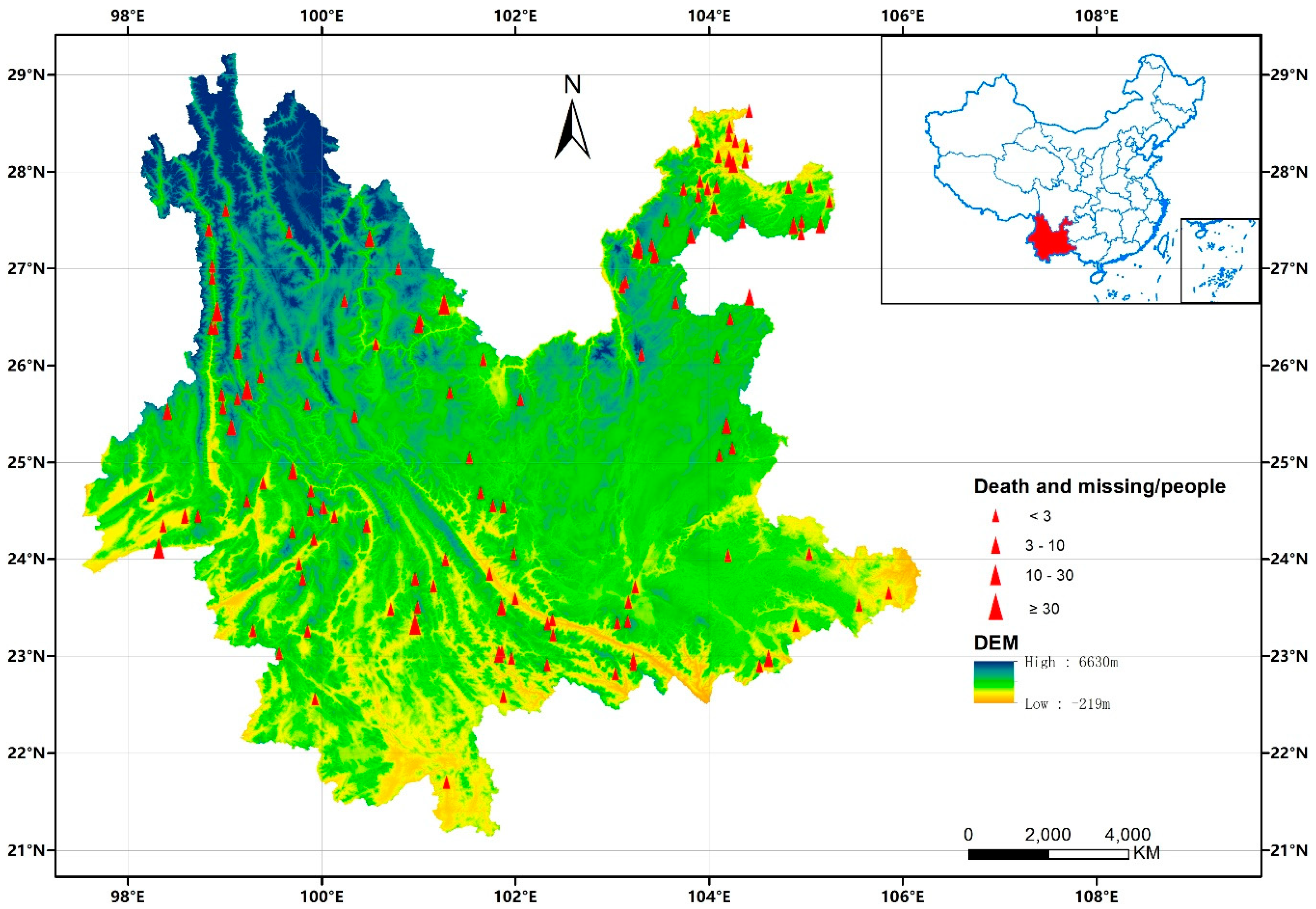

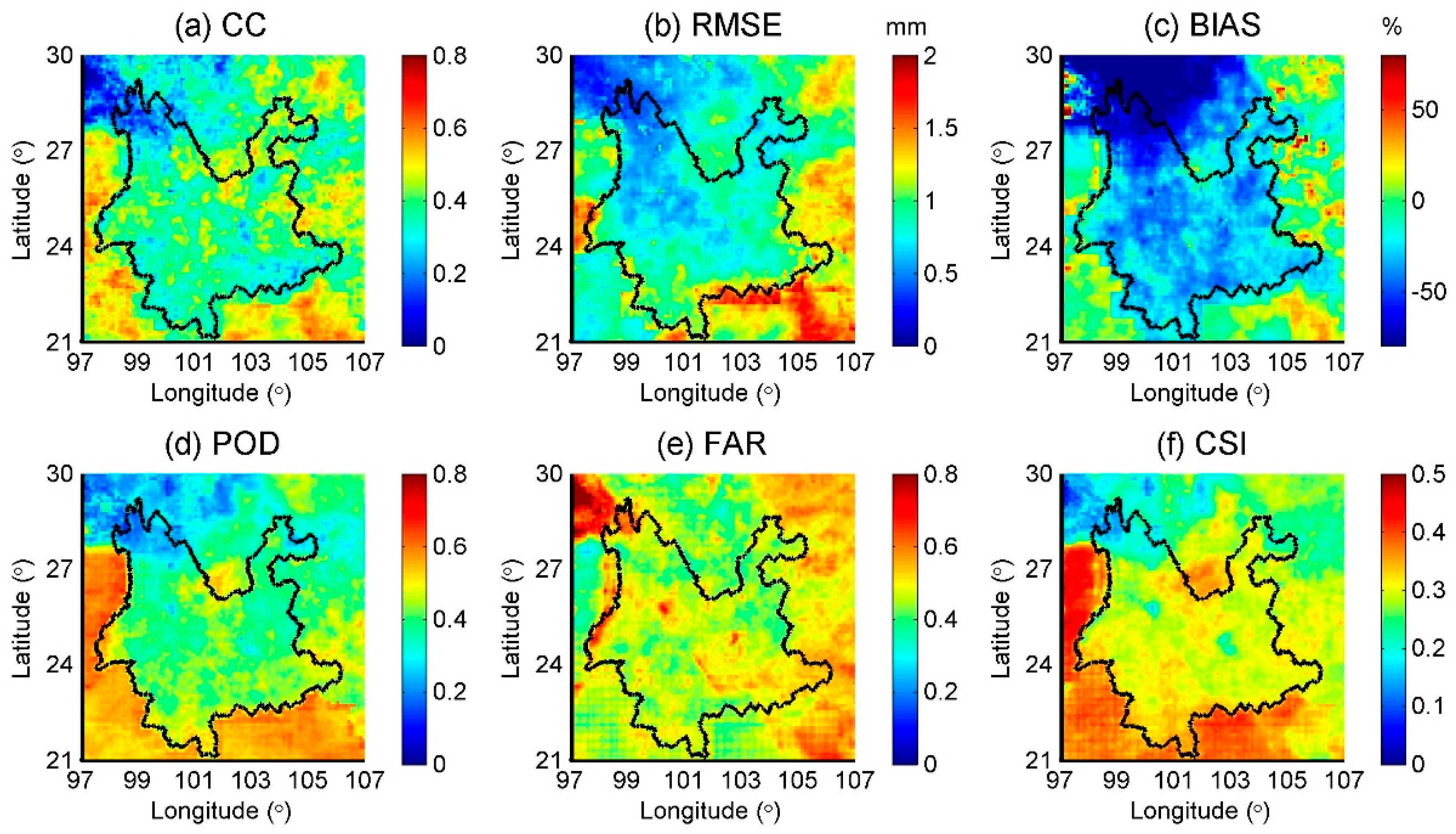
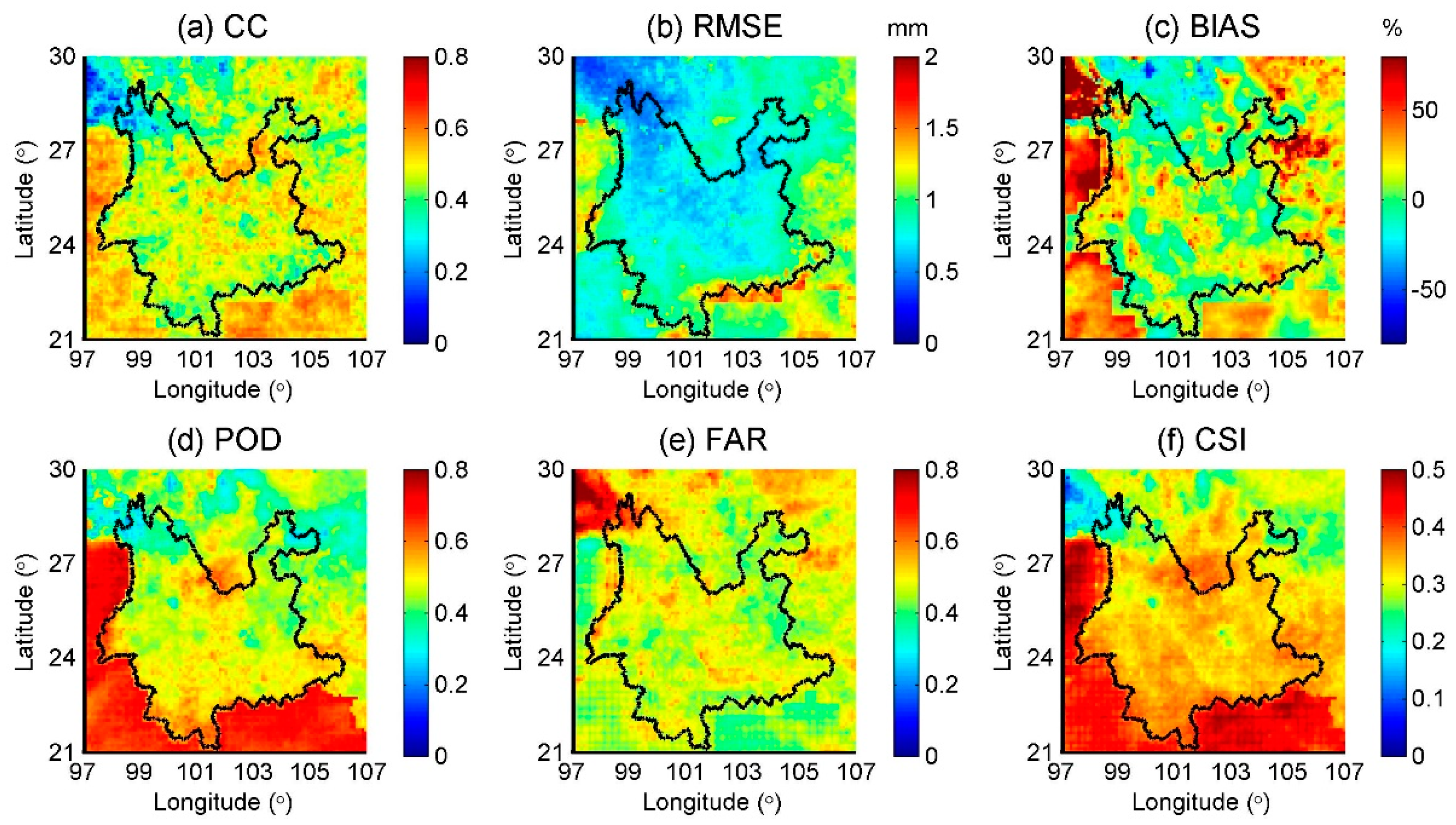
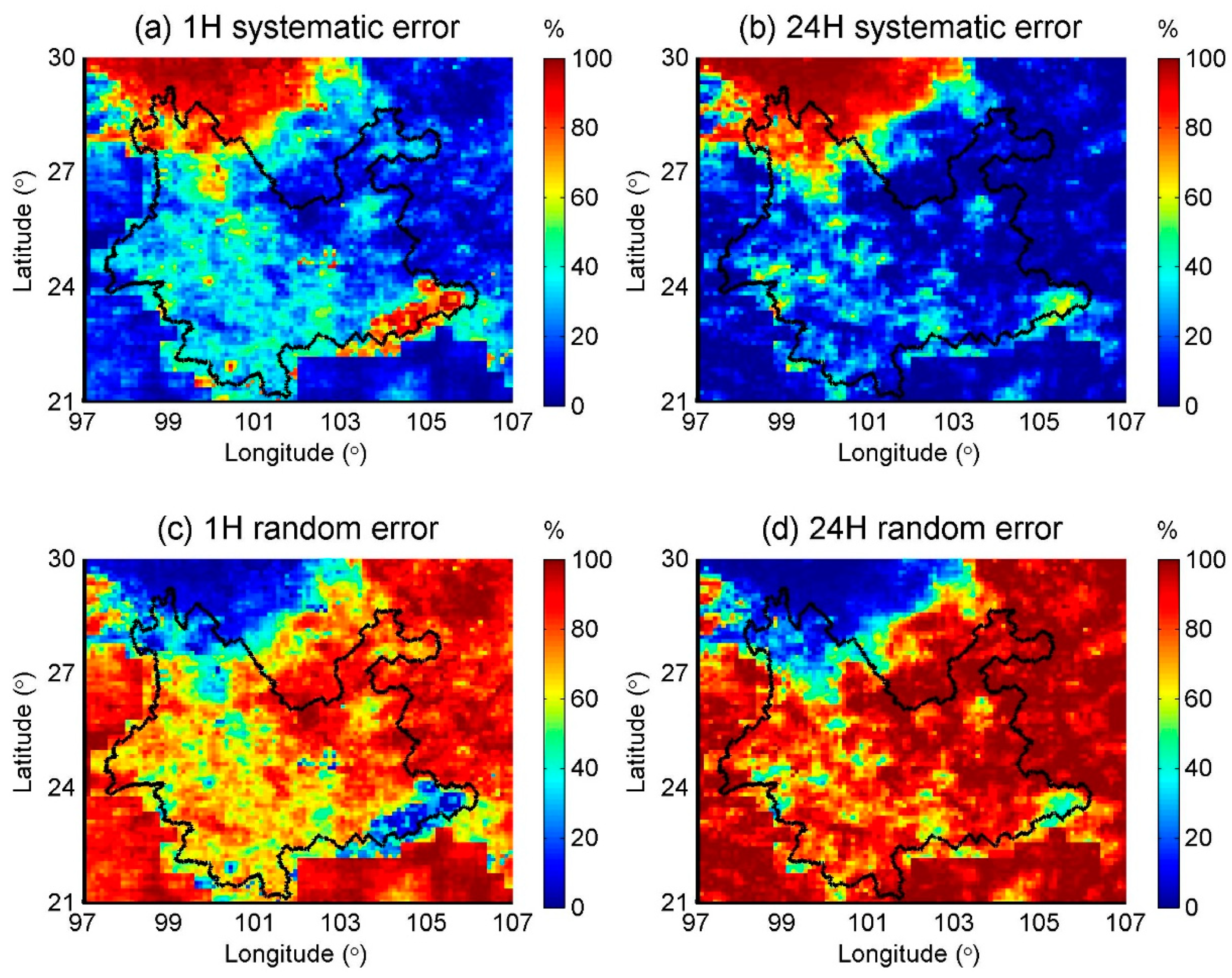
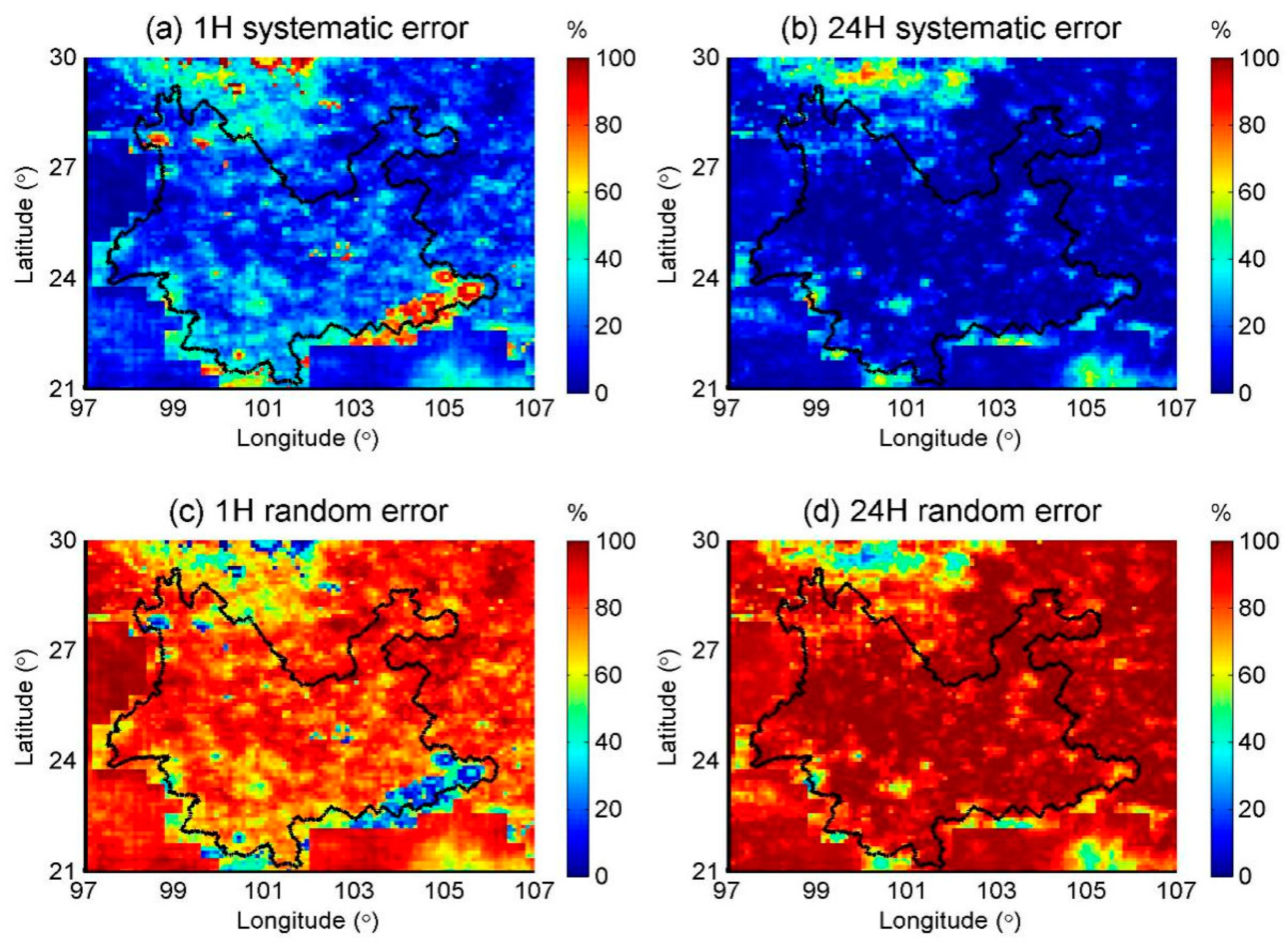
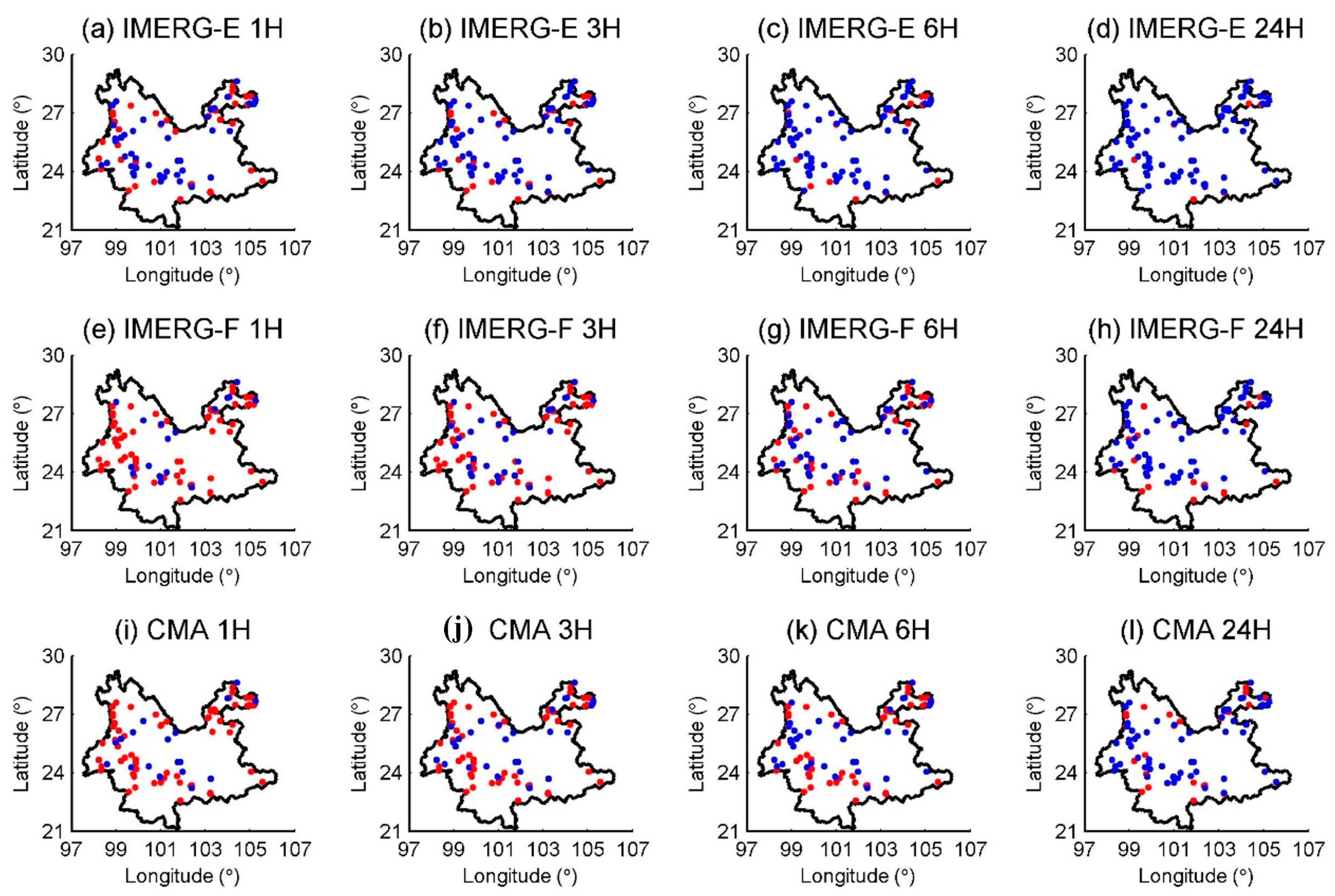
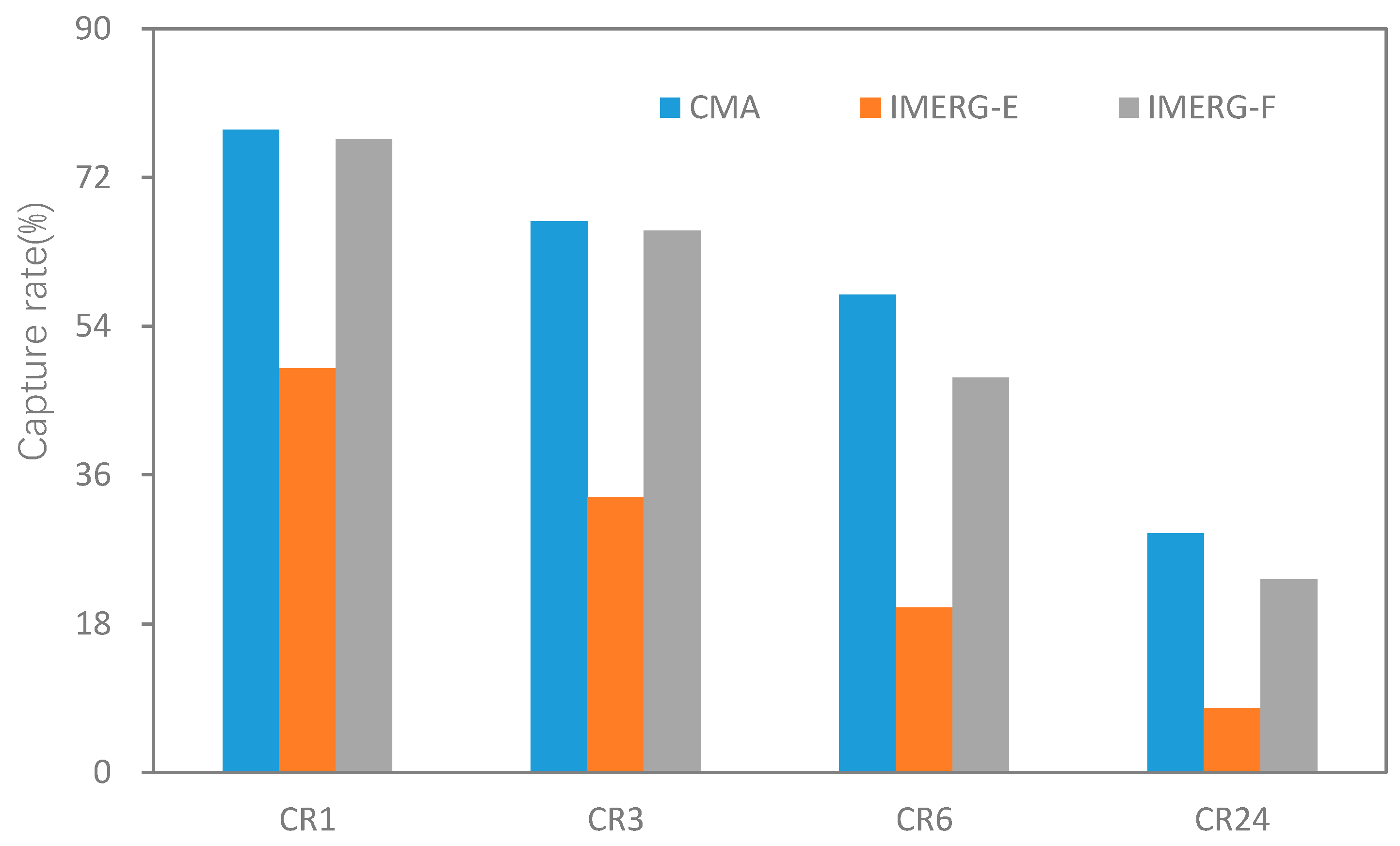
| IMERG-E | IMERG-L | IMERG-F | |
|---|---|---|---|
| Spatiotemporal resolution | 0.1°, 0.5 h | 0.1°, 0.5 h | 0.1°, 0.5 h |
| Lag time | 6 h | 18 h | 4 Month |
| Monitoring range | 90° N~90° S | 90° N~90° S | 90° N~90° S |
| Data period | Mar. 2015–Dec. 2018 | Mar. 2015–Dec. 2018 | Mar. 2015–Dec. 2018 |
| Diagnostic Statistics | Equation | Optimum Value | Value Ranges | Unit |
|---|---|---|---|---|
| CC | 1 | (−1,1) | - | |
| RMSE | 0 | (0, Inf) | mm | |
| BIAS | 0 | (−Inf, Inf) | % | |
| POD | 1 | (0,1) | - | |
| FAR | 0 | (0,1) | - | |
| CSI | 1 | (0,1) | - |
| Timescale | Product | CC | RMSE (mm) | BIAS (%) | POD | FAR | CSI |
|---|---|---|---|---|---|---|---|
| Hourly | IMERG-E | 0.41 | 1.1 | −0.69 | 0.39 | 0.53 | 0.27 |
| IMERG-F | 0.46 | 0.97 | 23.33 | 0.43 | 0.51 | 0.29 | |
| Daily | IMERG-E | 0.63 | 7.59 | −1.18 | 0.63 | 0.38 | 0.45 |
| IMERG-F | 0.73 | 5.74 | 28.24 | 0.66 | 0.34 | 0.48 |
© 2020 by the authors. Licensee MDPI, Basel, Switzerland. This article is an open access article distributed under the terms and conditions of the Creative Commons Attribution (CC BY) license (http://creativecommons.org/licenses/by/4.0/).
Share and Cite
Ma, M.; Wang, H.; Jia, P.; Tang, G.; Wang, D.; Ma, Z.; Yan, H. Application of the GPM-IMERG Products in Flash Flood Warning: A Case Study in Yunnan, China. Remote Sens. 2020, 12, 1954. https://doi.org/10.3390/rs12121954
Ma M, Wang H, Jia P, Tang G, Wang D, Ma Z, Yan H. Application of the GPM-IMERG Products in Flash Flood Warning: A Case Study in Yunnan, China. Remote Sensing. 2020; 12(12):1954. https://doi.org/10.3390/rs12121954
Chicago/Turabian StyleMa, Meihong, Huixiao Wang, Pengfei Jia, Guoqiang Tang, Dacheng Wang, Ziqiang Ma, and Haiming Yan. 2020. "Application of the GPM-IMERG Products in Flash Flood Warning: A Case Study in Yunnan, China" Remote Sensing 12, no. 12: 1954. https://doi.org/10.3390/rs12121954





